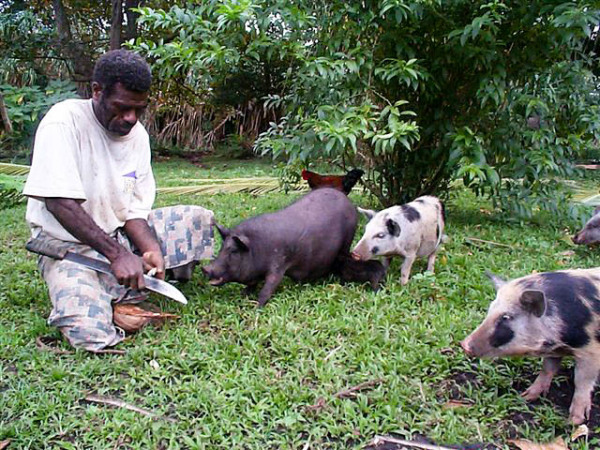Intersexual Pigs
OF
Vanuatu
Investigations Into the Relative Abundance of Intersexual Pigs in the Republic of Vanuatu
James K. McIntyre
Southwest Pacific Research Project
jmcintyre@swprp.org
Southwest Pacific Research Project
This article was originally published in "Science in New Guinea" vol. 22(3); 1997

Abstract
The existence and great abundance of a unique form of pig intersexuality was verified on the northernmost islands of Vanuatu.
Morphological examinations were conducted on 54 pigs from the islands of Malo, Ambae, and Aore. Through blood analysis, estradiol and testosterone levels were derived. Subsequent comparisons of the estradiol/testosterone ratio yielded results consistent with "maleness". Fifty-one dental and mandibular measurements of the Vanuatu Sus. sp. specimens plotted within the feral swine target group.
Behaviorally, the Vanuatu intersex pig exhibits periods of aggressiveness that generally coincide with a sow in heat. When encountered in the "bush", the naravé (local name for the intersexual pig) is a stronger and more aggressive adversary than the "normal" native wild pig. Six gross dissections yielded totally male internal sex organs. Four separate graduations or phases of the intersexual condition are described according to their external genitalia. The phases of intersexuality appeared to be an inherited trait. Certain sows (called falé-ravé) are known intersex producers and 20% of their offspring will be intersexual.
ntersexual Pigs with curved tusks, such as seen here, are highly valued among local peoples
Vanuatu's Native Intersexual Pig History and Description
Vanuatu's Native Intersexual Pig History and Description
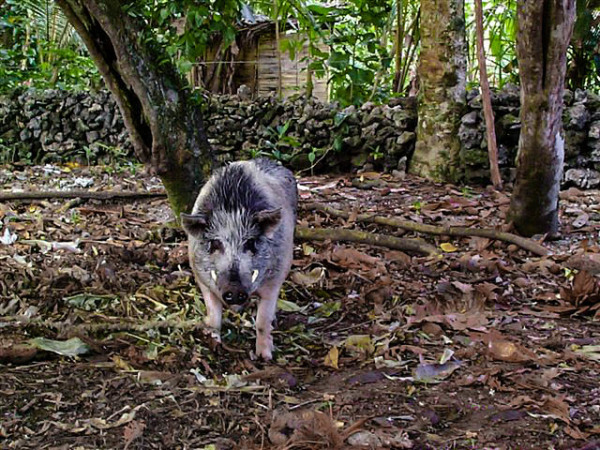
Vanuatu, a relatively young landform, appeared 22 million years ago when a series of massive deep ocean earth movements forced a chain of submarine volcanos to the surface(8). In addition to being a remote island group, Vanuatu has not had the time to evolve and develop the rich array of mammalian species as some of its closest mainland neighbors. Only six species of mammals are indigenous to these islands; all are bats, representatives of the suborders Megachiroptera (Flying foxes) and Micorchiroptera (insectivorous bats).
Most historians agree that the peoples of the Western Pacific originated in southeast Asia about 40,000 years ago, and through a series of migrations across Indonesia and the New Guinea chain, these people colonized many islands, including the Solomons and Vanuatu beginning about 3,000 B.C.(8).
This large, silver, tusked intersexual pig was kept tethered close to the owner's home for safekeeping
The earliest evidence of human occupation and settlement discovered in Vanuatu comes from a site on Malo Island in the northern part of the country. Archaeologists (9) claim that in about 1400 B.C., the most adventurous of these proto-melanesians (people of the Lapita culture) traveled by canoe and brought with them yams, taro and the predecessor of the native pig, Sus papuensis. This corresponds somewhat indirectly with some of the Malo peoples interpretation of the origins of the first life forms on that island. Through oral traditions, many locals still believe that the first humans to settle Vanuatu were also from Malo, but that they arose from a hole in Malo Pass. From this hole, along with the first man, also came the first Naravé (The national language of Bislama"s term for the intersex pig). Many people of Malo believe that their island was the first site of human and animal habitation. Contrary to popular European misconceptions, the first pig in the Islands did not arrive with Captain Cook in 1774, but with successive migrations of peoples from Northern Melanesia in much earlier times (1). Marshall (10) stated that, "No anthropologist would admit for one minute that such a elaborate and complex pig culture could be established in less than several centuries and it would be a biological impossibility anyway for it took centuries, co-related with native culture, to produce this incredible ratio of bisexual animals."
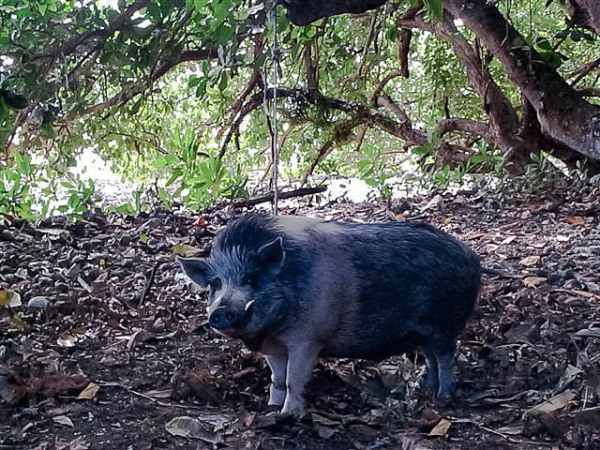
Sus sp.(Incorrectly termed Sus papuensis,these pigs are S. scrofa vittatus X S. celebensis hybrids)(11)(30), the ingigenous pig which is still thriving today, seems to have to adapted extremely well to the climatic and geographic conditions of Vanuatu. These pigs can be found on almost every island in Vanuatu in both the domesticated and wild states.
The most predominant characteristics of these pigs are those of hardiness, compact size and a long tapering snout. Much smaller than its European counterpart Sus scrofa, the adult boar will generally weigh no more than 100 kilograms. Hope (12) wrote in 1872 that "We found no difficulty in getting as many pigs as we liked for an adze apiece, but they were by no means in fine condition, and if it is true that these pigs are descendants of those left by Captain Cook in the last century, then they must have been wonderfully altered ... they are shaped like a West Indian peccary, black and hairy, long in the leg and hollow in every part they should be full, the only point in which they excel is biting".
This large, silver, tusked intersexual pig was kept tethered close to the owner's home for safekeeping
Sus sp. (incorrectly termed Sus papuensis) pigs are S. scrofa vittatus X S. celebensis hybrids) (11) (30), the ingigenous pig which is still thriving today, seems to have to adapted extremely well to the climatic and geographic conditions of Vanuatu. These pigs can be found on almost every island in Vanuatu in both the domesticated and wild states.
The most predominant characteristics of these pigs are those of hardiness, compact size and a long tapering snout. Much smaller than its European counterpart Sus scrofa, the adult boar will generally weigh no more than 100 kilograms. Hope (12) wrote in 1872 that, "We found no difficulty in getting as many pigs as we liked for an adze apiece, but they were by no means in fine condition, and if it is true that these pigs are descendants of those left by Captain Cook in the last century, then they must have been wonderfully altered ... they are shaped like a West Indian peccary, black and hairy, long in the leg and hollow in every part they should be full, the only point in which they excel is biting".
The colors of the native pig range from off-white to black. All colors and color patterns (i.e. spotted belted, and differential point coloration) (Hetzer(31)) are represented in these pigs, with the predominant color being an agouti/grizzled, ranging from light brown to black with lighter distal tips on the bristles. By proportion there seems to be a lower proportion of white and lighter colored animals apparently because they suffer severely from sunburn and do not thrive in these conditions and, thus have been naturally selected against(11). Sus spp. has a leaner body build as compared to the commercial high production varieties who have proven to be uneconomical in this humid tropical environment.
According to Weightman(12), Paddon probably introduced the first European breed of pig when, in 1845, he brought many kinds of livestock, including pigs, from Australia to Aneityum, an island in Northern Vanuatu. There have been, as one might expect, many subsequent crossings of the European with the native pig. According to local oral tradition as related by Cheif Joseph of Molo, along with the smaller body size comes a lighter body frame and skeletal system as exemplified in the skull thickness. I have been told on many occasions that "during the "Nimangki" (a ceremony celebrating a Ni-Vanuatu man's social climb), it should only take one powerful blow of the carved hardwood club to shatter the skull, thus killing the pig, whereas very often it takes several strikes to kill a European pig or one with European blood".

An Intersexual Pig investigates a stump
Many of the wild pigs are found in the dense bush and are joined there by wild cattle, dogs, and cats who have escaped disadvantaged domestic situations. These wild pigs are extremely nervous and wary of human encroachment. Sows with very small piglets and rutting boars in the presence of females in estrus, have been responsible for aggressive attacks on humans and animals. One thing to be noted though, is the excellent physical condition of these wild pigs as compared to their domesticated cousins. In the wild state they are able to realize the potential of their breed and thrive. Domesticated pigs of both European and wild blood, who are generally penned or tethered, are frequently ravaged by unchecked infestations of kidney worms (Stephanarus coleri)(12).
The sow is a good mother, giving birth to and successfully raising a limited number of piglets per litter (averaging 4 to 5 offspring) every 12 to 18 months in uncontrolled breeding situations (13). The young, being extremely precocious, can survive on their own after one week of age. All Piglets, however, do not have juvenile striped markings as stated by Weightman (12), but are born with the color and pattern they will possess at maturity. Of the 109 piglets observed in this study none was striped. One elderly pig pig owner recalled observing striped young in his youth.
Young sows have been bred as early as 6 months of age but generally a female is beyond one year of age when she first farrows. Piglets may be born in any month of the year and the gestation period seems to fall within the range of many other species of pigs (112 to 120 days). The average litter size of today's high production domestic swine is eleven piglets with the sows farrowing at least two times a year (14). The small size of Vanuatu's pigs and their reduced litter size have been mistaken for inbreeding in the past, but it is more appropriate to say that it is most likely an adaptation to maximize the nutritional, climatic, and geographical conditions available to residents of this tropical Archipelago.

A mother pig forages with her offspring
As in many areas of Melanesia, pigs were originally (but much less today because of the breakdown of "traditional ways") maintained in Vanuatu not as an item of daily consumption, but more importantly for the occasions of feasts, food exchanges, and trade. Pigs were used as payment for women in marriage and ritually sacrificed and feasted upon at "Nimangkis". In the northern part of Vanuatu, status within a village was earned by males through a series of grade-takings or "Nimangkis". The social system is dominated by accumulation and periodic sacrificing of pigs (preferably curved-tusked pigs). This tusked condition is produced by knocking out the top opposing canine teeth of a male or intersex pig at about 2 years of age. The opposing lower canine teeth grow unimpeded by wear, creating a complete circle by 7-8 years and after 12-14 years of intensive care and attention a double circle is obtained (4,12,14). Only such tusked pigs were of any importance to the men of early Vanuatu, whose main preoccupation was that of attaining chiefly status through "Nimangki". Even more important than a tusked boar was the tusked intersex pig, called Naravé. Thus, the intersex pig became the most important commodity in the social framework of men's lives in Vanuatu and remains so in many remote areas today.
Possible Geographic Origins of the First Narave Pig
Possible Geographic Origins of the First Narave Pig

Archaeological findings concur that the earliest evidence of permanent human occupation in Vanuatu comes from a site on Malo, an island off the southeast coast of Espiritu Santo. This area was first settled around 1400 B.C. by the peoples of the Lapita culture and along with them in their canoes they brought a unique style of pottery, subsistence vegetables and domestic animals such as poultry, dogs and pigs (9).
It is not hard to believe that through years of isolation, particularly on an island the size of Malo (17 km. long and 13 km. wide), that some degree of inbreeding must have occurred. It was perhaps as a result of one of these close matings that the first intersexual pig appeared. Through successive generations, and because of the value placed on this "unique" pig, it was no doubt recognized by these intelligent people, that even though the intersexes themselves were incapable of perpetuating their own kind, certain female pigs (the falé-ravé as they came to be called) occasionally produced these intersexual offspring while others did not. In addition to the dam of the Naravé, occasionally a female sibling of the intersex becomes a Naravé producer herself. Thus the sows carrying the genes were also highly valued and as a result of artificial selection, this small obscure bit of Melanesia now has, by far, the greatest ratio of porcine intersexuality yet discovered.
The island of Malo, site of Vanuatu's first permanent human occupation
Because of the rarity of this sexual aberration, and the fact that these pigs could produce the highly valued curved tusks, these pigs became prized possessions in the cultures that practiced "Nimangki" or grade-taking. It was from this time that the people of Malo Island began purposefully breeding a pig that could help them to more swiftly achieve the status of chief, as well as being important monetarily in trade with the people of neighboring islands.
It is also a fact that Malo, in time, became the center of a trade route connecting northern coastal Malakula with the main island of Santo and Tangoa Island (12). This trade route enlarged to include much of northern Vanuatu. It was along these routes that pandanus leaves, shell money, and domesticated animals were readily traded. It is my contention that the very first Naravé pigs were systematically bred on Malo Island, and then distributed throughout the northern islands of the Archipelago during trading sessions in return for goods and services. Further evidence of this could be obtained from the DNA of skin samples of intersex pigs from several remote areas of Vanuatu to ascertain their relationship, if any, to each other.


Pig tusks were highly prized by early Vanuatu peoples in the past.....
....And remain so in modern times
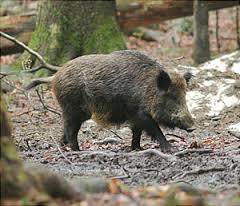
Distribution of Intersex Pigs
Distribution of Intersex Pigs
Intersex pigs are woven into the very fabric of Ni-Vanuatu culture. From the earliest accounts, (Coderington (15), Rivers (16), Baker (4), and Marshall(10) Intersexes appear to have been very numerous on many of the populated northern-most islands of Vanuatu. Two anthropologists, Coderington in 1891, and Rivers in 1914 made short references to intersex pigs while studying the diverse cultures of the New Hebrides. The first and only references to these intersex or integrade pigs were by Baker in 1925(17) and 1928 (4) where he stated, "on arrival in the northerly islands of this group, there were intersex pigs in every village of Espiritu Santo and Gaua". He continued, "little did anyone think that hidden away in a small group of islands in the Pacific were thousands of Intersexes" (although he only documented 91 in his findings).
Because of the difficulties in communication, and the remoteness of many villages, this report is by no means an absolute description of the distribution of population, domestic or wild, of these animals. It can probably be assumed that there are at least some intersex pigs in the approximate areas of their domesticated cousins as today's island pig management accounts for many cases of "escapees". I will begin with the original references and systematically account for their current distribution. The Intersexes referred to by Coderington (15) in 1891 and Rivers (16) in 1914 were merely references and mentioned only their cultural significance to the early "Tribesman" of the New Hebrides.
A Vunuatu Intersexual Pig
The "extreme abundance" of Naravé on the Sakau Peninsula (Baker(14))seems to have been drastically reduced to a point where the Author was unable to verify any accounts of Intersexual pig ownership in this area. There are still Naravé pigs kept on Gaua today, but not nearly in the numbers that were represented in "better times". Also in the northern Banks, Merelava accounts for two intersex pigs. There is an account of one intersex on the Island of Tongoa. Baker(4) also stated that on Efate and Malakula the intersexes did not occur. I was able to find accounts of the pigs on both of these islands. As recently as 1992 one was killed in South Malakula in an area where it had no ceremonial significance. Keeping Naravé pigs in northern Malakula, however, must have played a significant role in the early peoples' lives as was evident when a prominent Vao villager took me on a two hour walk into the bush, to a "Long forgotten" sacred "Taboo" place. Here he showed a lifesize, hand-crafted stone pig, with tusks. He related to me that this pig had been carved by his ancestors "many, many years before". Upon even closer examination I was excited to find out that this pig was indeed a hermaphrodite. This was to be my first introduction to tangible evidence of the existence of these unique aberrations.
I have recorded accounts of intersexual pigs still being kept for "custom" purposes (i.e. Nimangki ceremony) in the village of Patani on the nearly inaccessible northwest coast of Santo. These pigs are still evident on Ambae in the Northeast corner of the island, as is the case on Malo in its Northeast villages. These pigs are still plentiful by today's standards but not nearly as numerous as witnessed by Baker in 1925. On Malo alone in the area of Avunatari, 30 intersexes were examined. Villagers implied that there were additional animals in some of the adjacent bush villages. In the past 100 years there has been a great reduction in the number of intrsexual pigs on the Islands of Vanuatu. Two factors contributed directly to this reduction of these integrade pigs: massive human depopulation of the islands, through Blackbirding (a form of "labor recruitment" practiced here from 1803-1913), and disease brought by sandalwood traders and missionaries. Both factors were "coincidental" with a gradual diminishing practice of "custom ways" as is prevalent with many of the world's indigenous peoples. The progression of these and other environmental influences reduced the native population by almost 90% by 1935. White man's invasion and the strong arm of the missionaries insidious influence, which resulted in the loss of "old ways", began to undermine the very culture it came to save. By 1937 Marshall(10) stated "many other customs have been lost or seriously modified through the often brutal influence of white man's civilization .... while the people have lost a score of their important customs, they have grimly and tenaciously retained the culture of he pig". Today, only the elders maintain the practice of "Nimangki" and reverence of the Naravé pig. Along with this fading of tradition comes the influence of capitalism, the pig jaws with circular tusks that were once hung proudly on the "Big Man's" Nakamal (the name for the men's meeting place), now find themselves in downtown markets and jewelry stores for sale to tourists for hefty prices. It may then be a natural fact that when these proud men have gone "on top" (a place high in the mountains where one's spirit goes after death), the Naravé pig and its secrets will slip irrevocably into oblivion.

An Intersexual Pig
From personal interviews and past references(13), I was able to generalize that the Falé-Ravé (local term for a normal female pig known to have produced intersex offspring) will first farrow at approximately 1-1/2 years of age, and continue to be productive for 14 years, farrowing every 12-18 months (I'll use 15). Considering the average litter to be 4-6 (I'll use 5), birthing 12 times in her lifetime she will have produced approximately 60 piglets (50% male, 50% female). Of the expected 30 males born, each Falé-ravé is said to produce at least one Intersex in every farrow or approximately 20% of the offspring she produces(figures gathered from local lore). It is important to note that this only takes into account the small percentage of the population who are, in fact, "intersex producers" and not 20% of all males born to the entire population as Baker's figures represent. Nonetheless, this conservative estimation is still very impressive as the abundance of these intersexes is equaled nowhere in the world.
Genetics and Physiology
Genetics and Physiology
Vanuatu's intersex pigs combine features of both sexes, but are insufficiently developed for the purpose of reproduction. They, therefore, cannot be termed as true hermaphrodites. Hermaphrodites carry functional gonads of both sexes. The pigs represented on the Islands of Vanuatu are hence a unique form of intersexuality.
These pseudo-hermaphrodites, or more correctly now, male pseudo-hermaphrodites, differ in the fact they invariably lack all rudiments of ovary, oviduct, womb, and vagina. These animals, then, can actually be classified as modified boars.

From the earliest account(14), Baker states that the natives' story of the genetics of the abnormality neatly fits in with the assumption that it is caused by a sex-linked factor, intersexes being males carrying this factor. Intersex producing females ("falé-ravé" or "wurup kulaval" as they are referred to on the Sakau peninsula) would be heterozygous for the factor. Homozygous females can never occur in nature for they could only arise from the mating of two pigs, both of which carried the factor and this could never be the case without artificial insemination for the "would-be" males which carry the factor are intersexes whose copulatory organs are never sufficiently developed to function as such. Johnston (24) stated that the condition of intersexuality could be caused by a single pair of recessive genes, but other evidence indicates that the mode of inheritance is not that simple.
With todays knowledge of genetics, the inheritance of the intersex trait may not be as straight forward as stated by baker. The mere fact that there aremany graduations of the condition (four phases identified during the King Naravé project, and the seven phases mentioned by the Sakau people)(4) suggests that it is almost certainly a polygenic trait with incomplete dominance. There is also a strong possibility of secondary modifier genes as either the sex or autosomal chromasomes effecting the expression of the trait. Their is obviously a more complex genetic explanation behind this condition.
An Intersexual Pig on Vanuatu
The Vanuatu intersexual condition is actually that of a male-pseudohermaphroditic individual whose embryonic testes have secreted their hormones at a "later" point in development than is necessary to hormonally produce a "normal male". Further I would like to theorize that the organs targeted by the secondary sexual characteristics require stimulation for development at a definite "critical" point in the embryonic development of that animal and that if that point is passed without the minimum stimulus of hormonal influence, then no amount of hormone released later will cause them to fully develop into the normal male condition. Uterus and vagina are not formed simply because there is never any ovarian tissue.
The case of the "Feminine" pseudohermaphrodite, is simply a male in which the embryonic testes have developed much later than normal, after the vulva has already differentiated. The corpus cavernosum may develop and enlarge slightly and possibly modify the vulva, but essentially the external organ appears female condition. If the testes secrete their hormones earlier in the developmental time frame, the "Intermediate feminine" male pseudohermaphrodite will result. The corpus cavernosum will enlarge as much as 2 cm, and occasionally in this phase, the testicles are evident in the scrotum, although they do not appear to be fully developed. Even earlier development and hormone release will result in a condition in which normal sized testicles are fully descended into the scrotum but the enlarged urethral orifice ending is still situated below the anus, but closer to the testicles, and the vestigial vulva is reduced to a tiny slit. This phase will be referred to as the "tertiary feminine" male pseudohermaphrodite. The last phase, for which I only found one individual, was uniquely different. In this phase, the "transitional" male pseudohermaphrodite, the testicles were descended but a projection approximately 2 cm. long consisting of the ventral labial commissure, the corpus cavernosum, and the terminal part of the urethra, was situated near the anterior end of the scrotal region. Locals refer this as the "flying-fox" Naravé(4) as this genital configuration resembles that of the large native fruit bat (Pteropus sp.). What I suggest then is that these are all gradations of the same condition and differ only in the timing of hormonally-controlled developmental events.

Intersexual Pigs
A similar account is given by the Sakau people, but their interesting classification of the Naravé separates them into 7 groups according to their external genitalia. They are as follows(4):
1. Ndré-rasa - The "feminine" intersex - The external appearance is essentially that of the female, except for the presence, in adults, of tusks. The testes are situated within the abdomen. 2. Ndré-runedh - "sprouting coconut" intersex - Small projection by the vulva, with testicles sometimes descended into scrotum. 3. Ndré-narsogh - "sewn up" intersex - occasionally the urinary projection is situated in the scrotal region but the urinary external orifice is occluded. Soon after birth locals would make a small incision to allow normal urination. 4. Ndré-ghara - "fruit bat" intersex - the urinary projection is long and situated at the back of the testicles resembling the genitalia of the local bat. 5. Ndré-nau - "rat" intersex - Genitalia resemble those of the rat. 6. Ndré-ghor-ghor - "hidden" intersex - The urinary projection is smaller like that of the Ndré-nau, but it is not visible when viewed from behind. 7. Ndré-selet - "worm" intersex - There is a further enlargement of the corpus cavernosum moving the projection yet further on the abdomen with a resultant "worm-like" extrusion from the end.
These, as with the Authors classifications, commonly overlapped each other and at times were difficult to categorize. There does, however, seem to be a genetic influence involved in the inheritance of these conditions as certain families of animals in specific localities show there is clearly an inherited tendency to certain phases of this abnormality.
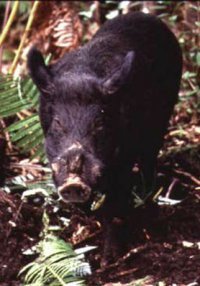
Intersex Pig Behavior
Intersex Pig Behavior
Behaviorally, the intersexes appear to act in a manner consistant with that of a normal male pig. These pigs frequently show periods of frustrated aggressiveness that may come as a result of boredom (as they are often isolated from other animals for safekeeping) or the physical inability to release sexual tensions.
Local villagers say that the Naravé, when encountered in the wild, is a much more aggressive and stronger adversary than its normal (male) wild, feral or domestic counterparts.
Johnston(20) commented on one male-pseudohermaphrodite in his study, "It was observed exhibiting male behavior .... It would ride gilts in heat and a penis-like organ would protrude from the vulva. In addition to the sex behavior, the pig was aggressive and would attempt to bite humans". ("Pseudohermaphrodites have the gonads of one sex but the external genitalia and secondary characters of the other, i.e. a male - pseudohermaphrodite has testes but possesses a female genotype) (6).
Vanuatu Intersexual Pig
Methods and Procedures
Methods and Procedures

In the last remaining strongholds where "custom" is still practiced, Naravé pig owners vehemently protect their most prized possessions. Many could not grasp the scientific aspect of my requests, while others, in a very direct manner, refused to allow me to "wound" their pigs in order to "take away" blood. It was at this point that Vira Joseph, the highly respected chief of Avunatari Village on Malo Island, came to my aid. Part contemporary/part "custom" man, Chief Joseph explained in words, as I never could, the importance of my study in regards to the preservation of their rapidly disintegrating "customs". He explained to the men of his village that by my studying and then recording the history of the Naravé pig, future generations might know the importance these animals played in the lives of their forefathers. With all that I, thankfully, was granted the opportunity to draw blood and obtain my "hands-on" documentation of ten pigs, seven of which were intersexual.
Examining internal anatomies was another problem altogether. Some owners would part with the young (without tusks) or inferior Naravé pigs with broken or missing tusks. The price range was from 8,000 to 80,000 vatu ($60 to $600 U.S.). With all but perhaps fetal pigs beyond the boundaries of this project's budget allotment, I purchased one young pig for dissection. Additional dissections arose from those animals ritually killed at upcoming Nimangki ceremonies rather than sacrifice any more from this unique gene pool for this study. I was not fortunate enough to be invited to the ceremony itself but was allowed to perform 6 gross anatomical examinations on the deceased pigs.
Intersexual Pig
The general body form, coat colorations, and natural histories from each morphotype were determined through field examinations, recent and past literature, personal interviews with Ni-Vanuatu villagers and actual specimens examined. All ages designated for each pig described in this study are approximate and originated from the owners account for each individual pig. The field weights were estimated by the author.
Personal documentation from actual sightings was my primary form of verification whenever possible. Distributional data were acquired through personal interviews, surveys, and service messages. Personal visits enabled verification of sometimes conflicting accounts of the existence of these animals and also allowed me to conduct field morphological and behavioral studies.
One particular procedure available to me was blood examinations (complete blood counts at the local clinic in Luganville and hormonal assays from serum sent to New Zealand with the aid of the Vanuatu Dept. of Agriculture). Three normal pigs (two normal males and one female) were also selected, in addition to the seven intersexes, to serve as controls. Each individual animal was hand-caught and manually restrained. The eyes were masked to disorient the pig, providing an opportunity to fasten a protective cushion around the valuable curved tusks before any attempt was made to throw the animal to the ground. The animal was restrained in lateral recumbency on its right or left side. With the legs and head restrained, a 21 ml. blood sample was drawn from the radial artery of the down-side foreleg. The external genitalia were examined and photographed. A skin biopsy (3 cm. diam. X 2 cm. thick, preserved in EDTA/TRIS) was removed from the up-side ear with a leather punch and a commercial premedicated, numbered, ear tag was inserted in the void left by the skin punch. (Owner's cooperation by their eagerness agreed to receive the "earring" as a gift). The pig was then released with the total procedure requiring 10 minutes per pig.

Personal documentation from actual sightings was my primary form of verification whenever possible. Distributional data were acquired through personal interviews, surveys, and service messages. Personal visits enabled verification of sometimes conflicting accounts of the existence of these animals and also allowed me to conduct field morphological and behavioral studies.
One particular procedure available to me was blood examinations (complete blood counts at the local clinic in Luganville and hormonal assays from serum sent to New Zealand with the aid of the Vanuatu Dept. of Agriculture). Three normal pigs (two normal males and one female) were also selected, in addition to the seven intersexes, to serve as controls. Each individual animal was hand-caught and manually restrained. The eyes were masked to disorient the pig, providing an opportunity to fasten a protective cushion around the valuable curved tusks before any attempt was made to throw the animal to the ground. The animal was restrained in lateral recumbency on its right or left side.
With the legs and head restrained, a 21 ml. blood sample was drawn from the radial artery of the down-side foreleg. The external genitalia were examined and photographed. A skin biopsy (3 cm. diam. X 2 cm. thick, preserved in EDTA/TRIS) was removed from the up-side ear with a leather punch and a commercial premedicated, numbered, ear tag was inserted in the void left by the skin punch. (Owner's cooperation by their eagerness agreed to receive the "earring" as a gift). The pig was then released with the total procedure requiring 10 minutes per pig.
Intersexual Pig
Complete Blood Counts(CBC's) and hormonal assay interpretations were run on seven intersexual pigs, (D, E, F, J, K, L, and M) table(1)(2), two normal males, C, N) and one pregnant female (B). Their CBC's were compared against the normal blood values for swine used at the Western College of Veterinary Medicine, University of Saskatchewan, Canada. These blood values have been compiled from the clinical laboratory, Department of Pathology; from O W Schalm(18) et al (1975) and Kaneko(19) (1980). Normal values of laboratory data are offered as a guide and it must be noted that values may vary depending on the individual laboratory as well as the sex, age, and geographical habitat of the target research animal.
The quality controls for testosterone were at 2 ng-assayed 2.4 ng (120%), 5.00 ng-assay 4.49 ng (90%), 10 ng-assayed 9.54 (95%). The quality controls for estradiol were at 20 pg-assayed 19.37 pg (97%), 50 pg-assayed 53.22 pg (106%) and 100 pg-assayed 146.37 pg (146%).
For testosterone 200 ul of sample was extracted with diethyl ether for assay.
For estradiol 3 ml of sample was assayed using the method described by Webb et al(35). The intra-assay coefficients of variation were 8% for testosterone and 9% for estradiol.
The antiserum for DHT was the same as that used for testerone. It was used at a dilution of 1:300. Major cross-reacting steroids were 5alpha dihydrotestosterone 75%, 5beta dihydrotestosterone 75%, 5alpha androstan-3alpha, 17beta-diol 37.5%, 5beta androstan-3alpha, 17beta-diol 16.5%, androstenedione 0.1%. The antiserum used for the estradiol assays was raised in an ovariectomized ewe against oestradiol-6 (O-carboxymethyl) oximine bovine serum albumin conjugate used at a dilution of 1:16000. The major cross-reactions of other steroids were estrone 7.3%, estriol 1.4%, estradiol 17alpha 1.4% and androstenedione 0.015%.
Results
Results

CBC'S of the ten animals all fell within, or on the periphery of the range of norms for swine (Table 1). The research animals consisted of pigs ranging in age from approximately one to seven years. All animals came from the same area on Malo Island.
Upon first observation (Table 2), the hormonal values of the representative samples cannot by themselves be interpreted. The ratios of estradiol to testosterone were generated and the following general conclusions may be drawn. Ratios greater than unity have been generally designated as female and those less than one generally designates maleness (27). Like the two normal males, all seven of the intersexes showed ratios less than 1.0.
These observations seem to support the theory that Vanuatu's intersexual pigs are actually mal-developed boars. Pig "B", said by locals to be a pregnant female, showed a progesterone level of 10.6 ng/ml, consistant with that of a pregnant sow.
Vanuatu Intersexual Pig
The results of the Dihydrotestosterone (DHT) test on the sera of pigs D,E,F,J,K,L,M were consistent with maleness. Of the 54 animals on which external examinations were conducted, there was a high degree of variability, the most common occurrences were in testicular (number, size, and location) and urogenital configuration. Findings for the intersexes varied from very "female" looking external genitalia with no testicles to a descended scrotal sac containing two large well-developed testicles. Within this range were many different testicular presentations including an empty scrotal sac, one degenerate descended testicle, one large testicle, and one large and one small testicle represented. Of the animals examined, 61% or 33 animals exhibit no testicles whatsoever, 10 (or 19%) possessed 2 well-formed scrotal testicles, 8 (or 15%) had 1 normal descended testicle, and the remaining 5% had 1 small and 1 large or 1 small testicle present. As the intersexes' testicular development approached that of the "normal male" condition, there was a corresponding change in the position and length of the ventral labial commissure (V.L.C.) and the urogenital aperture. When there were no testicles or scrotum present, the vulva seemed almost undifferentiable from that of the normal female organ except possibly for a slight reduction of the urogenital opening, and the presence of the corpus cavernosum (C.C.) may push the (V.L.C.) dorsally and laterally. The terminal end of the urethra is distinguished from the corresponding structure of the normal female by the presence of the bulbo-cavernosus. Correspondingly, as the testicles become larger and descend into the scrotum, the V.L.C. appears to become larger as the C.C. itself enlarges and begins to turn ventrally, taking the V.L.C. with it. The most developed phase that was examined was that of the "transitional" male pseudohermaphrodite in which two large testicles were situated in the scrotum and the projection, now much longer than before, consisting of the V.L.C., the C.C. and the terminal end of the urethra, was situated directly anterior to the scrotum. Despite all of these varying phases of genital development, each of these animals, as an adult, consistently exhibited tusks, with a base diameter consistent with that of the male of the species. As expected those animals exhibiting 1 external testis (whether it appeared normal or degenerate) also contained 1 degenerated testicle within the abdomen. In one case, however, a young animal(Pig A) with no external testicles or scrotum, possessed only 1 small but well-formed testis inguinally. No vestige of the other testicle was detected. In most cases, the testicles appeared to be more or less degenerate or totally so. The vulva had a reduced urogenital aperture. There were never any rudiments of vagina, cervix, uterus, oviduct or ovaries evident in any of the intersex pigs examined, which concurs with Baker's findings in 1928(4).The urine was delivered from the bladder via the urethra to the external opening anteriorly corresponding with its specific phase of intersexuality. At the terminal end of the urethra there was a bulbo-cavernosus muscle which aids, in normal males, in expulsion of urine or sperm. In all cases, the internal anatomies were wholly male, although in various stages of development. Seminal vesicles, bulbo-cavernosus muscle, and corpus cavernosus were evident in every individual. Bulbo-urethral glands were found in all but one individual.
Table 1
Intersexual Pig Study
Table 2
Intersexual Pig Study
Conclusions
Conclusions
After six weeks of following empty leads, the first intersexual pig was observed on the island of Aore in Northern Vanuatu. During the following month fifty-three additional examples of this rare mammalian anomaly were documented. External descriptions and approximate ages and weights of these animals were recorded. Behavioral studies yielded indications of patterns of aggressiveness with the Intersexual pigs kept in villages.
These periods often coincided with the heat cycle of a sow in the vicinity. When encountered in the bush, locals attribute an increased display of aggressiveness and strength to this intersexual condition. I was able to plot the Naravé's current distribution which is greatly reduced as compared to the original references in the early part of this century. Approximately 20% of all offspring born to the falé-ravé (intersex producing female) will themselves be intersexes. This conservative estimation is still very impressive and the abundance of these pseudohermaphrodites is equaled nowhere in the world. From local lore and description it is the dam who is the sole contributor to the intersexual condition.
After studying the internal anatomies of six Naravé, the findings were consistent. With the exception of the external vulva-like organ, there were never any rudiments of female internal genitalia. There were however, generally two testes (either intra-abdominal or scrotal), seminal vesicals and bulbo-urethral glands. These animals were actually "modified" boars and more correctly termed male pseudohermaphrodites. These individual's embryonic testis had secreted their hormone during a "later" part of development than is necessary to hormonally produce a normal sexually developed male. In regard to the external genitalia, four distinct phases were identified and documented.
Eleven animals were selected for blood examination of which; eight were intersexuals, two were males and one was a pregnant female. All eleven animals fell within or on the periphery of the range of cbc norms for swine. Hormonal of estradiol and testosterone were generated from each of the test animals. The ratio of estradiol to testosterone yielded numbers consistent with "maleness" from the two males as well as the eight intersexuals these results support my theory that Vanuatu's intersexual pigs are actually mal-developed boars.
Although many locals insist that it is the female that is the sole contributor to the intersexual condition, (falé-ravé, mother or sister of an intersex, the soké-rave is the brother of an intersexual), a comprehensive controlled breeding program with test-crosses is necessary to corroborate this. In normal village "management" situations, chance breeding occurs and the sires are rarely known. There is a distinct possibility that two carriers for the trait (soké-ravé and falé-ravé) must come together in order to produce the abnormal condition in some males and not in others. A compliment to controlled breeding would be artificial insemination. Because of the positioning of the "penis" in all of these intersexes, normal reproduction is a physical impossibility.
The possibility of electro-ejaculation and artificial insemination, using the intersex as a donor, must not be overlooked. Baker (15) stated, "There appeared to be a few abnormal sperms in the testes of one of the nine individuals while all of the others examined lacked spermatogenesis altogether". With the size and appearance of the testicles on many of the mature animals, I have no reason to doubt the possibility of the presence of viable sperm. The simple solution to the genetics of the abnormality as stated by Baker (4) is probably more complex. The sex-linked inheritance conclusion as proposed by Baker is more than likely a polygenic trait with incomplete dominance (this explains the many graduations of the condition). There is also the possibility of secondary modifier genes either on the sex or autosomal chromosomes.
In accordance with Canonical Variates Analysis (5) (CVA), 51 mandibular measurements were taken on Vanuatu adult male Sus spp. specimens. As illustrated on Graph 1, most of the Vanuatu pigs plotted either in or adjacent to the feral swine target group. Specimens of S. celebensis and S. papuensis (believed by C. Groves (11) to be a hybrid between S. scrofa and S. celebensis) also plot with feral S. scrofa. What is curious and demands further study are those four specimens that do not plot within any of the target groups.
With the development of modern cytological methods of sex-determination, the Karyotype of each individual needs to be determined. There is a possibility that the chromosome number of Intersexes varies from those that have been cited in the literature.
One pig intersex has been reported (Laing (6)) to have a condition comparable to Klinefelter's Syndrome in man. In many cases though animals which are chromosomally abnormal in either the autosome or sex chromosomes, are spontaneously aborted early in gestation. Considering the above, along with my investigations of the internal anatomy and the relative normal behavior of these intersexes, I would predict the presence of a chromosome number comparable to those previously documented (28) (29). Because of many of the limitations mentioned earlier in the introduction, this study can only approximate a complete examination to the study of intersexuality in Vanuatu.
I hope to have set the foundation for more comprehensive studies, and that this paper will serve as a guide for those wishing to pursue this interesting phenomenon. This project should, however, bring the Naravé "mystique" up to date, and for the questions left unanswered, serve to encourage further investigation.

Intersexual Pig
Acknowledgements
The author would like to Acknowledge the following: Special thanks to my Ni-Vanuatu crew, especially my friend Jeffry Vutilolo. Many thanks to my Sponsors, Perez Trading Company Miami, Florida and (George (cash in advance please) Davis. Ralph Regenvanu at the Vanuatu Cultural Center. Lastly for his generous assistance, Kirk Huffman - I Thank You.
Bibliography
Vanuatu Expedition Image Gallery
1996
Vanuatu Expedition Image Gallery
1996
The author, James K McIntyre, "Mac", is please to share with you the images from the 1996 Vanuatu Expedition. Use the arrow keys to scroll through the images or click on the gallery to view in expanded mode.
-
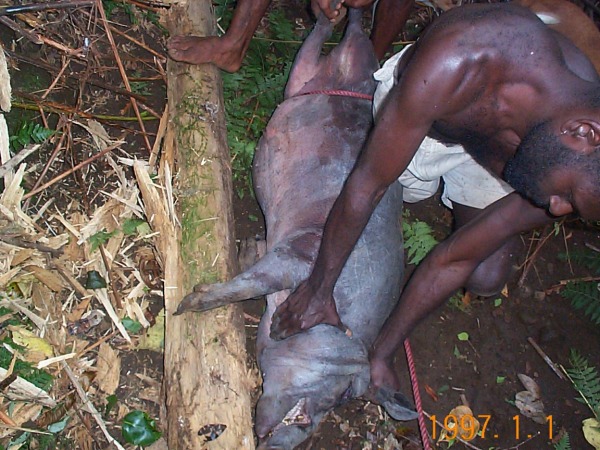
-

-

-

-
 2016 Vanuatu Expedition
2016 Vanuatu Expedition -

-

-
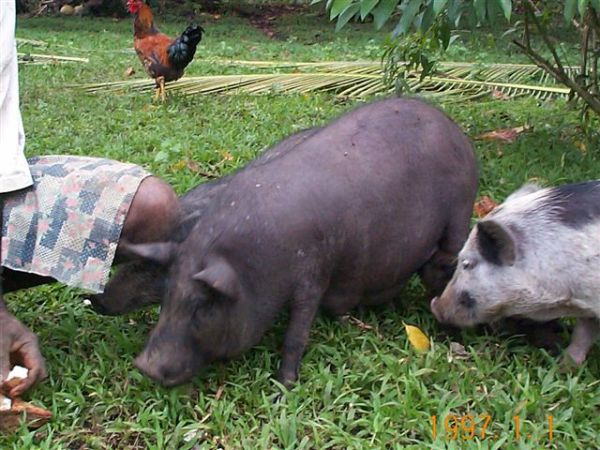
-
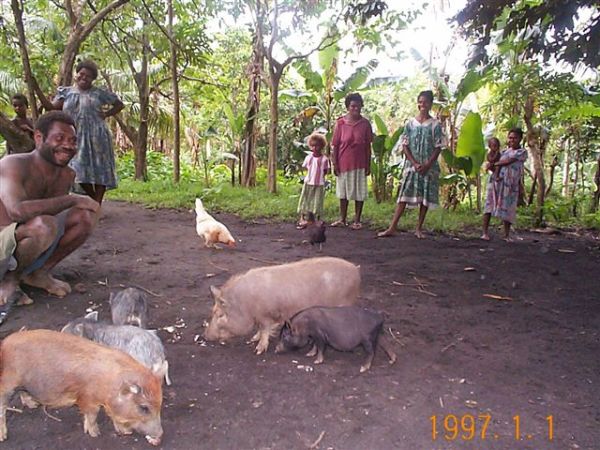
-

-

-

-

-
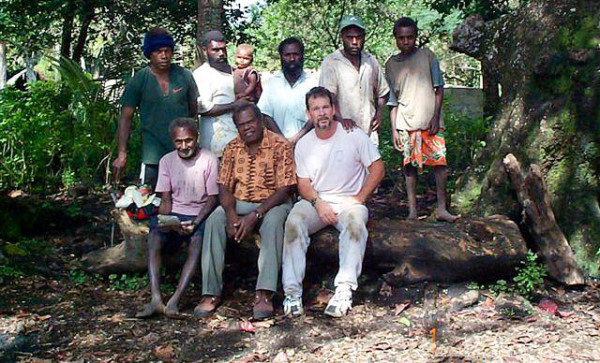
-
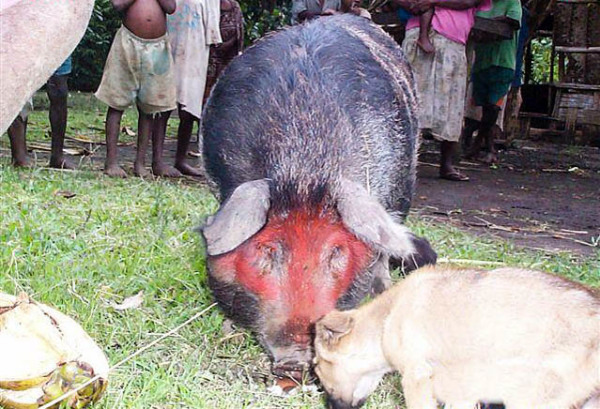
-

-

-
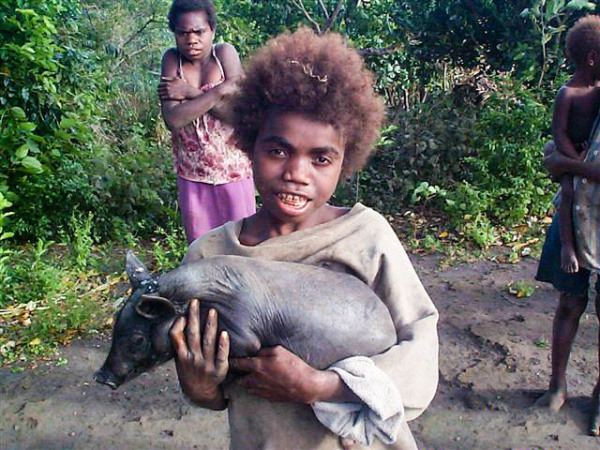
-

-
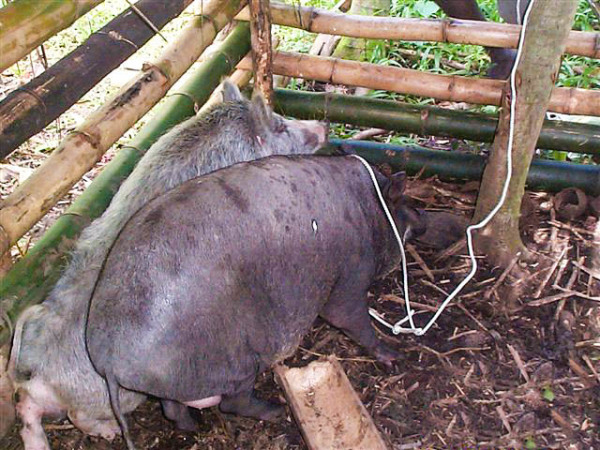
-

-

-
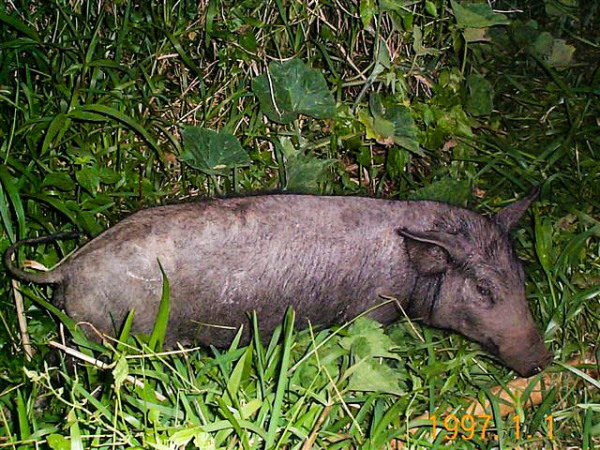
-
